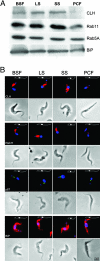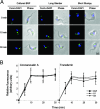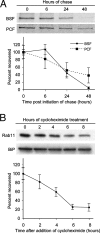Activation of endocytosis as an adaptation to the mammalian host by trypanosomes
- PMID: 17905918
- PMCID: PMC2168407
- DOI: 10.1128/EC.00213-07
Activation of endocytosis as an adaptation to the mammalian host by trypanosomes
Abstract
Immune evasion in African trypanosomes is principally mediated by antigenic variation, but rapid internalization of surface-bound immune factors may contribute to survival. Endocytosis is upregulated approximately 10-fold in bloodstream compared to procyclic forms, and surface coat remodeling accompanies transition between these life stages. Here we examined expression of endocytosis markers in tsetse fly stages in vivo and monitored modulation during transition from bloodstream to procyclic forms in vitro. Among bloodstream stages nonproliferative stumpy forms have endocytic activity similar to that seen with rapidly dividing slender forms, while differentiation of stumpy forms to procyclic forms is accompanied by rapid down-regulation of Rab11 and clathrin, suggesting that modulation of endocytic and recycling systems accompanies this differentiation event. Significantly, rapid down-regulation of endocytic markers occurs upon entering the insect midgut and expression of Rab11 and clathrin remains low throughout subsequent development, which suggests that high endocytic activity is not required for remodeling the parasite surface or for survival within the fly. However, salivary gland metacyclic forms dramatically increase expression of clathrin and Rab11, indicating that emergence of mammalian infective forms is coupled to reacquisition of a high-activity endocytic-recycling system. These data suggest that high-level endocytosis in Trypanosoma brucei is an adaptation required for viability in the mammalian host.
Figures








Similar articles
-
Stumpy forms are the predominant transmissible forms of Trypanosoma brucei.Elife. 2025 Jun 16;12:RP91602. doi: 10.7554/eLife.91602. Elife. 2025. PMID: 40522086 Free PMC article.
-
Cold shock and regulation of surface protein trafficking convey sensitization to inducers of stage differentiation in Trypanosoma brucei.Genes Dev. 2004 Nov 15;18(22):2798-811. doi: 10.1101/gad.323404. Genes Dev. 2004. PMID: 15545633 Free PMC article.
-
Social motility of African trypanosomes is a property of a distinct life-cycle stage that occurs early in tsetse fly transmission.PLoS Pathog. 2014 Oct 30;10(10):e1004493. doi: 10.1371/journal.ppat.1004493. eCollection 2014 Oct. PLoS Pathog. 2014. PMID: 25357194 Free PMC article.
-
Bloodstream form pre-adaptation to the tsetse fly in Trypanosoma brucei.Front Cell Infect Microbiol. 2013 Nov 14;3:78. doi: 10.3389/fcimb.2013.00078. eCollection 2013. Front Cell Infect Microbiol. 2013. PMID: 24294594 Free PMC article. Review.
-
Antigenic variation during the developmental cycle of Trypanosoma brucei.J Protozool. 1984 Feb;31(1):41-7. J Protozool. 1984. PMID: 6204043 Review.
Cited by
-
High-throughput decoding of antitrypanosomal drug efficacy and resistance.Nature. 2012 Jan 25;482(7384):232-6. doi: 10.1038/nature10771. Nature. 2012. PMID: 22278056 Free PMC article.
-
Endocytosis and Sphingolipid Scavenging in Leishmania mexicana Amastigotes.Biochem Res Int. 2012;2012:691363. doi: 10.1155/2012/691363. Epub 2011 Sep 21. Biochem Res Int. 2012. PMID: 21941657 Free PMC article.
-
Requirement for acetyl-CoA carboxylase in Trypanosoma brucei is dependent upon the growth environment.Mol Microbiol. 2011 Apr;80(1):117-32. doi: 10.1111/j.1365-2958.2011.07563.x. Epub 2011 Feb 16. Mol Microbiol. 2011. PMID: 21306439 Free PMC article.
-
Nanobodies As Tools to Understand, Diagnose, and Treat African Trypanosomiasis.Front Immunol. 2017 Jun 30;8:724. doi: 10.3389/fimmu.2017.00724. eCollection 2017. Front Immunol. 2017. PMID: 28713367 Free PMC article. Review.
-
The heart of darkness: growth and form of Trypanosoma brucei in the tsetse fly.Trends Parasitol. 2009 Nov;25(11):517-24. doi: 10.1016/j.pt.2009.08.001. Epub 2009 Sep 9. Trends Parasitol. 2009. PMID: 19747880 Free PMC article. Review.
References
-
- Bangs, J. D., E. M. Brouch, D. M. Ransom, and J. L. Roggy. 1996. A soluble secretory reporter system in Trypanosoma brucei. Studies on endoplasmic reticulum targeting. J. Biol. Chem. 271:18387-18393. - PubMed
-
- Bangs, J. D., L. Uyetake, M. J. Brickman, A. E. Balber, and J. C. Boothroyd. 1993. Molecular cloning and cellular localization of a BiP homologue in Trypanosoma brucei. Divergent ER retention signals in a lower eukaryote. J. Cell Sci. 105(Pt. 4):1101-1113. - PubMed
-
- Barrett, M. P., R. J. Burchmore, A. Stich, J. O. Lazzari, A. C. Frasch, J. J. Cazzulo, and S. Krishna. 2003. The trypanosomiases. Lancet 362:1469-1480. - PubMed
-
- Barry, J. D. 1979. Capping of variable antigen on Trypanosoma brucei, and its immunological and biological significance. J. Cell Sci. 37:287-302. - PubMed
Publication types
MeSH terms
Substances
Grants and funding
LinkOut - more resources
Full Text Sources

